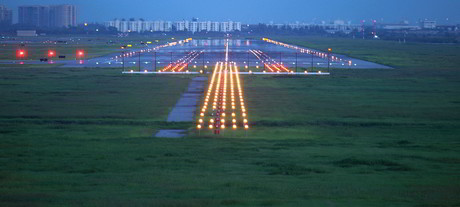Interference elimination on the air-bands

Tracking down an intermittent source of interference has safeguarded operations at a busy airport.
All airports need clear, reliable radiocommunications in order to operate efficiently and safely. But at one particular Australian airport — which has more than 100,000 aircraft movements each year — air traffic controllers in the control tower had experienced, over a long period of time, interference on aircraft radio channels.
Previous attempts to locate the source of the interference had proved futile due to its short-term duration and spasmodic occurrence; typically it would be observed for only a few seconds at a rate of less than once per day.
Vicom provided the necessary engineering expertise together with nodes and software (manufactured by CRFS) to locate the source of interference and enable the airport to eliminate the problem.
The CRFS equipment was set up both within the equipment room and in the outside environment to monitor and record RF spectrum in appropriate bands. The aim was to determine if the interference was coming from within the equipment room or from a transmitter source outside, and identify its nature and source.
A scanning rate of twice per second was used, and data was captured over a one-month period. The timing of interference events was noted by the control tower operators. The collected data was then analysed for events at the times reported.
Using the analysis software it was possible to look at the spectrum at one-second intervals and match these with the timing of audio recordings of voice radio traffic. It became clear that the source of interference was external to the equipment room.

Several sources were identified. Some were illegally operated devices being used by workers in the area, but the majority were caused by aircraft transmitting on one frequency and producing spurious emissions on, or close to, other control tower frequencies. It was possible to recognise the interference signature of aircraft and relate these to the aircraft call-signs. The transmissions from both the tower and aircraft could be clearly identified.
Key factors in achieving this result were:
- The ability to set up 24-hour-per-day continuous logging of spectrum.
- The detail with which the spectrum could be logged (resolution bandwidth).
- The rate at which the sweeps could be repeated to capture short-duration events.
- The tools to analyse the resulting data to pick out relevant parts and display in detail the individual spectrum sweeps and integrated power-vs-time data.
An example of analysed data is shown on this page. The screenshot displays spectrum, waterfall and integrated power data over a one-minute period. Transmissions shown are 5 seconds from aircraft, 10 seconds nil, 3 seconds from the control tower, 4 seconds nil, 1 second from aircraft, and 5 seconds from the control tower.
As a result of the finding, remedial action was focused on cleaning up the transmissions from the particular aircraft identified.
Please follow us and share on Twitter and Facebook. You can also subscribe for FREE to our weekly newsletter and bimonthly magazine.
Achieve accurate RF measurements by understanding spectral purity
Selecting a signal generator with high spectral purity ensures that the measurements signify the...
Signal generators: does analog or digital make a difference?
With so many options, it's important to understand which signal generator is best to achieve...
Using AI to build your next-gen wireless system
The central challenge engineers face when designing wireless systems and networks is their...




